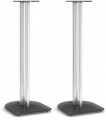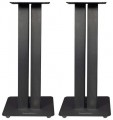Compatible speaker model
Models of acoustic systems for which the stand was originally designed. This parameter greatly facilitates the choice for a specific set of speakers — the stands are guaranteed to be compatible with the "native" speakers without any problems. This does not exclude the possibility of using acoustics that are not claimed compatible — the main thing is that the speakers are suitable in size and acoustic properties.
Acoustic spikes
The presence of
acoustic spikes in the design of the stand.
Such spikes are pointed protrusions on which the structure rests during installation. To avoid damage to the floor, you can use special protective pads with such protrusions (colloquially — "pyataki"); some models are initially equipped with similar overlays, for others, protection must be purchased separately.
Anyway, both acoustic stands and various designs for Hi-Fi equipment can be equipped with spikes (see "Type"). Depending on the application, the function of such devices will also be different. So, in models for speakers, spikes reduce the area of contact with the floor, increasing pressure and providing the most rigid connection of the rack (and, through it, the speaker cabinet) with the supporting surface. Due to this, unnecessary ("parasitic") vibrations that occur in the speaker cabinet are extinguished, and the sound quality improves; more details about the specific nuances of using spikes for speakers can be found in special sources. In extensions for Hi-Fi cabinets, spikes can also perform another function — they work as clamps (for more details, see "Type"). And in fact, in the cabinets, this piece of equipment plays a predominantly decorative role. Also, in all cases, the spikes are usually made adjustable in height, which allows you to adjust the fulcrum to the unevenness of the floor.
Maximum load
The largest weight of equipment that can be placed on a given piece of furniture.
It is worth considering that in multi-tiered Hi-Fi cabinets (see "Type") the allowable weight may be indicated in different ways. If this paragraph indicates one number without additional clarifications, then it should be considered as the maximum load on the entire structure, which is divided “equally” between the shelves. For example, a cabinet with a 30 kg limit and three shelves will have a 10 kg limit per shelf. In some models, it may be specified that we are talking about the load on each individual shelf. Sometimes in such cases the load is distributed unevenly — most often the lowest tier is the most “hardy”, and it is its characteristics that are indicated as the main ones. Similar points in our catalog are specified in the notes.
Material
The main material used in the construction of furniture.
Note that in different brands (and even in different models of the same brand), this characteristic can be designated differently. For example, for cabinets with metal shelves with wooden lining, one manufacturer may indicate the option "metal / wood", the other — only "metal". So if this parameter is fundamental for you, it's ok to further clarify the composition of the design using illustrations, reviews and other special sources.
In terms of specific materials,
metal,
wood and
plastic are the most popular in modern acoustic furniture. However, they can be used both individually and in various combinations. Here is a more detailed description of the different options:
— Metal. The most popular material for furniture of all types nowadays; the only exception is Hi-Fi cabinets, where wood is more common — however, here it is often combined with metal. The specific composition of the metal may be different, but almost all options have a common set of advantages, which led to the prevalence of this option. Firstly, metal structures with the same allowable load have a smaller thickness and weight than wooden ones. Secondly, they are extremely durable and reliable, which allows you to create products for almost any weight (and in the case of wood, this is difficult). Thirdly, by properly
...combining different metals and alloys in one construction, very good acoustic characteristics can be achieved (which is especially important for speaker stands). Fourthly, due to the variety of metals, furniture of any price category can be created from this material — from low-cost to elite. The design of metal products can be different, but most often it is a strict minimalist "hi-tech"; in this matter, the choice depends solely on the tastes of the user.
— Wood (MDF). Racks and pedestals made entirely or almost entirely of wood, more specifically medium density fibreboard. It is this material that is designated by the abbreviation "MDF". In acoustics, it is considered a good alternative to natural wood: MDF is almost as good as it in terms of acoustic properties, but it costs much less. On the other hand, this material is less durable and reliable than metal, which is why MDF products must be quite thick — otherwise they will not achieve the necessary strength. Accordingly, such models are quite heavy and more expensive than most metal counterparts. In light of all this, solid wood products are relatively rare nowadays, and they are chosen for two reasons. The first is the subjective preferences of the listener: some music lovers believe that a wooden speaker stand gives the sound a special warm colour that is inaccessible to metal (although this is more a matter of self-hypnosis than objective advantages). The second is an aesthetic point: some models use MDF with a veneer finish that mimics the texture of natural wood. However, note that such material may require special care.
— Metal / wood. Models in the design of which both materials described above are used. At the same time, specific combinations of wood and metal can be different. So, the standard option in Hi-Fi cabinets (see "Type") is a combination of wooden shelves with metal supports, and among acoustic stands there is both this option and the opposite — a wooden column with a platform and base made of metal. Anyway, from an objective point of view, the meaning in such a combination is more aesthetic than practical: the working properties of such products may be different, depending on the design features and selected materials. However, as with the all-wood constructions described above, some users find that the use of wood in speaker stands has a positive effect on sound coloration; this moment is purely subjective, but it can also significantly affect perception.
— Metal / glass. A relatively rare option is a combination of metal parts with glass. Usually, horizontal elements are made of glass (platforms and/or bases of racks, shelves of Hi-Fi pedestals), and vertical supports are made of metal, which bear the main load during use. The main advantage of such structures is a characteristic style that is perfect for high-tech interiors. On the other hand, even the thick tempered glass used in such structures does not withstand strong impacts well. In addition, such surfaces are easily contaminated, and to maintain cleanliness they need to be constantly wiped. That is why this combination is not popular. Note that most products in this design refer to racks (see "Type").
— Plastic. Plastic structures, sometimes supplemented with metal elements in the most "critical" places. The key advantage of plastic is its low cost, but this, in fact, exhausts its advantages. But the reliability of this material is rather low, it does not tolerate high loads; the situation can be corrected by the mentioned metal inserts, however, they significantly affect the cost. Also note that there are high-strength varieties of plastic, but they are also expensive, so in fact it is more reasonable to use metal instead of such materials. As a result, there are very few plastic products on the market — mainly wall-mounted models (see "Type") for home use, designed for light and low-power speakers.Platform dimensions (WxD)
Dimensions of the platform used to install acoustics. In some stands, for which this parameter is also indicated, the clamp can play the role of a platform — in such cases, we are talking about the overall dimensions of the working area in the clamp.
It makes sense to pay attention to this parameter if the stand does not have a specialization for a specific brand of acoustics, or it is planned to be used with a “non-native” speaker (see “Speaker model”). In such cases, it is desirable that the dimensions of the platform coincide as closely as possible with the dimensions of the base of the speaker — otherwise distortion in the sound may occur. In addition, a speaker that is too small will look unaesthetic on the stand, and one that is too large will not have the necessary stability.
Height
General dimensions of the Hi-Fi pedestal (see "Type") in width and depth.
Recall that the depth in this case is the size from the front to the rear edge of the structure. In general, information about the dimensions is needed primarily in order to assess how much space you need to prepare for placing the cabinet and where it is better to put it. In addition, the overall width and depth determine how much shelf space will actually be available for mounting various equipment. However, the dimensions of this space are often specified separately in the characteristics — as the effective width and depth (see above); and when evaluating compatibility with various devices, it is best to use specialized dimensions rather than general dimensions. If the effective width and depth are not indicated in the specifications, it is worth proceeding from the fact that they are somewhere 150–200 mm smaller than the corresponding overall dimensions, and take the appropriate margin when selecting a cabinet for the existing components.
Weight
Total weight of the stand; in paired sets, it is indicated for each item separately.
It is widely believed among audiophiles that the heavier the design, the less “ringing” it is, the lower the likelihood of extraneous vibrations and the better the stand performs its functions. However, this is only partially true: manufacturers often use various design tricks (for example, an internal frame) to reduce weight without sacrificing quality.

